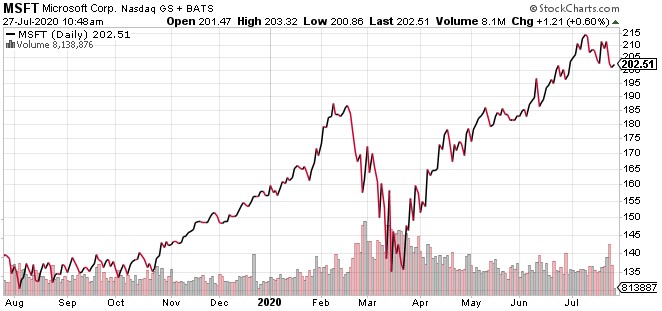Why Microsoft Has Flourished While Intel Has Failed
In the 1990s, Wintel, the partnership between Microsoft’s (Nasdaq: MSFT, Rated “B+”) Windows and Intel (Nasdaq: INTC, Rated “B”) that created the x86 chips, was unstoppable.
The two tech giants reported financial results last week. Microsoft outperformed, while Intel shares slid 16%.
The divergence between the two runs much deeper than a single quarter’s earnings. Where Microsoft eagerly looked to new products to bolster its profits, Intel bosses said their legacy products should suffice until 2022.
Depending on legacy products for growth is never good enough.
However, the situation could have been reversed. For a long time, Microsoft was only about Windows, its dominant personal computer operating system. “Windows Everywhere” was its strategy to deploy the operating system to data centers, mobile devices, video games and computers of every sort.
In a July 2013 memo, then CEO Steve Ballmer told employees the company was in a unique position to leverage the platform’s 1 billion users. He thought he could squeeze them all into some device running Windows, whether they liked it or not.
Related post: AMD is Revolutionizing the Gaming Industry at Just the Right Time
History teaches us these shoehorn strategies work better on paper than in real life. Regardless, to bolster the Windows Phone lineup, Ballmer engineered the buyout of Nokia (NYSE: NOK, Rated “D+”). In contrast with the euphoria of Apple’s (Nasdaq: AAPL, Rated “B-”) iPhone, the move was an unmitigated disaster. Two years later, The Verge noted the cost of failure was the staggering sum of $8 billion. But Microsoft managers learned from this mistake.
The value of Microsoft to customers wasn’t Windows crammed onto their smartphones and Xboxes. The value was the digital services the company offered.
When Satya Nadella became new chief executive in 2014, this new strategy kicked into high gear.
Microsoft began deploying its services across other platforms. The Office productivity suite migrated to iPhones and Androids. Windows Azure, its cloud computing service, became Microsoft Azure. And product managers went all out to attract Linux developers to the platform.
By March 2018, Windows was not even a division at Microsoft. Engineers who once focused entirely on the operating system were split up between Azure and Office 365, the cloud-based version of the best-selling productivity suit.
Ben Thompson, an analyst at Stratechery, explained the end of Windows succinctly. The internet reduced application lock-in. PCs became good enough, so customers didn’t upgrade as frequently. And smartphones changed the way people sourced information.
Microsoft managers adapted.
Intel managers show no such signs. If anything, they are making the same mistakes all over again.
The Santa Clara, Calif.-based microprocessor company announced Thursday that its next generation of 7-nanometer (nm) chips would be delayed at least six months due to manufacturing problems. Intel had similar holdups during prior transitions to 14nm, then 10nm. In the interim, PC and data center customers were forced to use slower, less efficient chips.
Unfortunately for Intel, times are changing.
Related post: Tech Stocks That Will See Through This Turmoil
Customers are no longer locked in. Many are jumping to Advanced Micro Devices (Nasdaq: AMD, Rated “C+”), a competitor with 7-nm inventory. Others are striking out on their own, but these days custom designed microprocessors can be farmed out to state-of-the-art foundries like Taiwan Semiconductor (NYSE: TSM, Rated “C+”) for scaled production.
Apple announced in June that it would ditch Intel as a supplier for Mac computers and has already begun designing proprietary chips for its laptops. The first batch of these will debut later in 2020, according to a report in the New York Times.
Hyperscale data center customers, like Amazon.com (Nasdaq: AMZN, Rated “C+”), Alphabet (Nasdaq: GOOGL, Rated “B”) and Microsoft, are exploring alternatives to Intel chips, too. These large cloud companies are designing bespoke chips that are better suited for the artificial intelligence and machine learning software that has become a staple of modern software-as-a-service business models.
For example, Google researchers in 2016 revealed that custom-made TensorFlow silicon was stealthily speeding up machine learning at its Google Cloud data centers. The chips are especially useful for voice recognition and natural language applications.
Longer-term, the writing is on the wall. Intel’s biggest customers have a good alternative in Advanced Micro Devices. Many others also have the wherewithal to make their own custom, value-added microprocessors.
For now, Intel chiefs refuse to see what’s going on.
Cognitive dissonance is easier when current data center demand for cheap x86 is strong. Sure, these 10nm processors now have lower profit margins. Second-quarter financial results showed gross margins slowed to 53.3%, down 6.6% from a year ago. But a 43% spike in demand helped overall revenues reach $19.7 billion, up 20%.
Bob Swan, Intel’s chief executive officer, says demand for older chips should continue for at least two years. It’s a short-sighted viewpoint that ignores the fact customers are no longer locked in. It also neglects that the rules of the game have been changed. Intel is now competing head to head with TSM, a company with a long history of getting to the market first.
All of this is being accurately reflected in stock prices. Intel shares are up only 15% during the past two decades. That is a compound annual growth rate of just 0.7%. By contrast, Microsoft stock has rallied 760% during the same time frame, a CAGR of 11.4%.
Microsoft succeeded where Intel failed because managers recognized the market was evolving. Customers didn’t want to be locked in. So the company changed course. It became a digital first, cloud-based business.
While Intel is still the largest vertically integrated microprocessor company in the world, its position is trickier and far more uncertain. Their future is full of lower margins and slower sales growth as customers begin to design and contract custom chips supplied by TSM.
Best wishes,
Jon D. Markman





